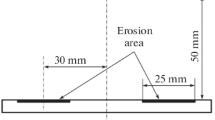Abstract
This paper, the third and final of a three part series, presents the electrical properties of postdeposition annealed, lead lanthanum titanate (PLT) thin films deposited by multi-ion-beam reactive sputtering (MIBERS). Also, a model is presented that explains the relations among composition, crystallographic structure, microstructure, and electrical properties of the PLT thin films. Thin films of PLT consisting of the perovskite phase exhibit (100) textured microstructures. Addition of a critical quantity of excess PbO results in the loss of this (100) texture, and continuity of the perovskite phase is disrupted while both excess PbO and porosity phases become continuous due to a percolation effect. Films with textured microstructures consisting of a continuous perovskite phase exhibit relatively high dc resistivities, high dielectric permittivities, and high remanent polarizations. At the transition between textured and nontextured microstructures, a discontinuous drop in the electrical properties occurs due to the ensuing continuity of the excess PbO and porosity. These composition-induced changes in the electrical properties were quantitatively modeled by applying a simple mixing rule model to the microstructure model developed in Part II of this series.
Similar content being viewed by others
References
L. Pauling, The Nature of the Chemical Bond, 3rd ed. (Cornell University Press, Ithaca, NY, 1960).
S. C. Abrahams, S. K. Kurtz, and P. B. Jamieson, Phys. Rev. 172 (2), 551 (1968).
F. Jona and G. Shirane, Ferroelectric Crystals (Pergamon Press Inc., New York, 1962), pp. 160–171.
W. D. Kingery, H. K. Bowen, and D. R. Uhlmann, Introduction to Ceramics, 2nd ed. (John Wiley & Sons, Inc., New York, 1976), pp. 516–580.
G.R. Fox, S.B. Krupanidhi, K.L. More, and L.F. Allard, J. Mater. Res. 7, 3039 (1992).
G. R. Fox, S. B. Krupanidhi, and K. L. More, J. Mater. Res. 8, 2191 (1993).
W. A. Geideman, IEEE Trans. Ultrason. Ferroelec. Freq. Control 38 (6), 704 (1991).
L. H. Parker and A. F. Tasch, IEEE Circ. Dev. Mag. 6, 17 (1990).
H. Adachi, T. Mitsuyu, O. Yamazaki, and K. Wasa, Jpn. J. Appl. Phys., Supplement 24–2 24, 287 (1985).
R. Takayama, Y. Tomita, K. Iijima, and I. Ueda, J. Appl. Phys. 61 (1), 411 (1987).
C.E. Land, J. Am. Ceram. Soc. 72 (11), 2059 (1989).
D. Hennings and K. H. Härdtl, Phys. Status Solidi A 3, 465 (1970).
D. Hennings and G. Rosenstein, Mater. Res. Bull. VII, 1505 (1972).
T. Yamamoto, H. Igarashi, and K. Okazaki, J. Am. Ceram. Soc. 66 (5), 363 (1983).
K. Keizer and A.J. Burggraaf, Ferroelectrics 14, 671 (1976).
L. K. H. van Beek, in Progress in Dielectrics, edited by J. B. Birks (Heywood Books, London, England, 1967), Vol. 7, pp. 69–114.
Mercury Probe, Model Hg-102RD, MSI Electronics, Inc., Woodside, NY.
Programmable Electrometer, Model 617, Keithley, Cleveland, OH.
Computer, Model 9121, Hewlett Packard.
Impedance Analyzer 5 Hz–13 MHz, Model 4192A, Hewlett Packard.
A. R. Von Hippel, Dielectrics and Waves (John Wiley & Sons, Inc., New York, 1954), pp. 86–91.
Pulse Generator, Model 24B, Hewlett Packard.
Tektronix Digital Oscilloscope, Model 2430A, Tektronix Inc., Beaverton, OR.
V. M. Gurevich, Electric Conductivity of Ferroelectrics (U.S. Department of Commerce, National Technical Service Information Service, Springfield, VA, 1971), pp. 1–29.
H. E. Brown, Lead Oxide-Properties and Applications (International Lead Zinc Research Organization, Inc., New York, 1985), pp. 153–193.
R. C. Weast, CRC Handbook of Chemistry and Physics, 64th ed. (CRC Press, Inc., Boca Raton, FL, 1983), p. E-76.
H. K. Henisch, Semiconductor Contacts (Clarendon Press, Oxford, 1984).
G. R. Fox and S. B. Krupanidhi, J. Appl. Phys. 74 (3), (1993).
G. R. Fox, Composition/Structure/Property Relations of Ferroelectric Lead-Lanthanum-Titanate Thin Films Deposited by Multi-Ion-Beam Reactive Sputtering, Ph.D. Thesis, The Pennsylvania State University (1992).
G. R. Fox, E. Breval, and R. E. Newnham, J. Mater. Sci. 26, 2566 (1991).
O. Yamaguchi, A. Narai, and T. Komatsu, J. Am. Ceram. Soc. 69 (10), C-256 (1986).
K. Ishikawa, K. Yoshikawa, and N. Okada, Phys. Rev. B 37 (10), 5852 (1988).
D. S. McLachlan, M. Blaszkiewics, and R. E. Newnham, J. Am. Ceram. Soc. 73 (8), 2187 (1990).
Author information
Authors and Affiliations
Rights and permissions
About this article
Cite this article
Fox, G.R., Krupanidhi, S.B. Composition/structure/property relations of multi-ion-beam reactive sputtered lead lanthanum titanate thin films: Part III. Electrical properties. Journal of Materials Research 8, 2203–2215 (1993). https://doi.org/10.1557/JMR.1993.2203
Received:
Accepted:
Published:
Issue Date:
DOI: https://doi.org/10.1557/JMR.1993.2203




